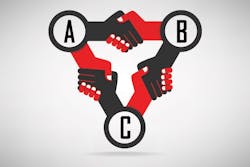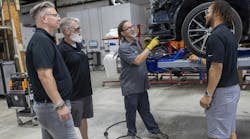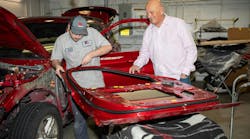In theory, the idea of company culture is simple: It’s the foundation.
“Culture is critical because culture is the foundation from which everything else is done,” says Rich Altieri, president of Autobody Management Solutions.
Shops need a “winning” culture, he says, one that promotes efficiency and ensures that employees stay motivated on a daily basis.
The problem for multi-shop operations, Altieri says, is creating consistency across every shop.'
“Consistency in how they process work, shop management, how they handle customer service,” he says. “The difficulty is not the theory part.”
Although the execution of culture can be difficult, successfully building a unified culture across multiple locations will not only improve consistency and efficiency, it will also help the business run more smoothly, says Lou Berman, vice president of customer support at Collision Care Centers, an eight-shop, $20 million-a-year operation in Philadelphia.
“I’ll tell you for an owner, it’s important to have a unified culture across all fronts,” Berman says.
Berman and Altieri discuss the five keys to building a better culture at an MSO.
1.) Set Core Values
It all comes back to core values, Berman says.
“It’s really important for shops to develop an ideology or a set of philosophies they want to adopt when it comes to their management and employees,” he says. “There should be common core values that transcend regional operations.”
- Rich Altieri, president of Autobody Management Solutions
A shop’s culture starts with the core values, Alteri says, which should be defined, written out and communicated to all staff.
For Collision Care, the majority of the company’s goals are focused on the customer experience and what customers want to receive out of the repair process—low cycle time, cost-efficient repair orders and quality work. Altieri says other examples of core values could be teamwork or trust, or world-class workmanship.
From there, the core values should be used to set the vision and mission of the business. The vision, Altieri says, is where you want the company to be, while the mission is how you’re going to get there.
“If the vision was to be within the top 100 MSOs, the mission is how we’re going to get there,” he says. “We’re going to get there by continually improving and delivering the best performance, speed, quality and cost.
2.) Align staff around the vision
One of the most predictable reasons that change fails is if the whole company is not aligned around it, says Altieri. When it comes to culture, you’re asking the whole company to change, meaning they all need to be involved in the alignment.
“If I don’t include those people in the development of the core values and the vision and lead them there, it’s not their vision. Therefore they’re not aligned with it,” he says. “The reason it’s like that in collision is because leadership hasn’t done a good enough job communicating and gaining alignment around the vision, the core values, what we’re going to change and the sense of urgency.”
At Collision Care, that alignment starts with the managers. The leadership team needs to be engaged, Berman says, or else any changes or attempts at consistency will fail. He says that the leadership team frequently has meetings together that touch on various aspects of the operation.
“When you have multiple stores, you’re going to need a system to have a good set of checks and balances,” he says. “That’s one of the main reasons we take the manager’s position very seriously. The leadership is communicating the mission.”
Altieri also recommends conducting an employee satisfaction survey to get a true sense for employee opinions on the company and verify that everyone is on the same page. Results from those surveys can be used to steer conversation and touch on points that leadership may have overlooked otherwise.
“It’s funny because what the leaders think the answers are going to be and what the employees answer aren’t always aligned,” he says. “Employee satisfaction is a big part of that. At the end of the day, the only way you’re going to have the best culture is if you have the best people.”
3.) Train Thoroughly
A culture can’t succeed if the entire staff isn’t being trained sufficiently, says Altieri. Everyone from owners and managers to the technicians and front office staff need to be trained. Otherwise, inconsistency is bound to occur.
“If they don’t understand what you’re talking about, they’re not going to be able to be engaged or add value,” Altieri says. “We always talk about the impatient visionary. They come back and want to see change happen immediately. We introduce them to the things we’re going to be doing. Then we go on the floor and coach them.”
Collision Care conducts significant amounts of in-house training to instill a culture of continuous improvement. The shop brings outside trainers to the shop to conduct training around lean manufacturing to help technicians stay in tune with better ways of working and promote deep analysis of shop operations. The company has also hired a phone communication training firm to help its estimators improve customer interactions, and through that, CSI scores. It’s one of the reasons Collision Care has maintained consistent CSI scores and 147 percent monthly technician efficiency levels across all locations.
The company also conducts one-on-one coaching and feedback sessions between the technician and management to support technicians who are striving toward improvement. The company developed a standardized coaching form that identifies a specific improvement that needs to be made, steps that will be taken to make the improvement, and a process to monitor incremental improvements during a 60–90-day period. The form form is used any time technicians slip below a certain efficiency benchmark as a way to eliminate lingering problems.
4.) Implement Procedures
You need to let employees know how to win each day.
Thorough, written and strictly enforced standard operating procedures are a must, as are position contracts and performance requirements.
“Employees need and want structure,” Berman says. “What we’ve found is that we really stress organization and adoption of standards and adherence to those standards. When we’re dealing with customers or insurance companies, you want to have a nice base ground rule set of policies and procedures.”
Everyone needs to understand their roles and daily tasks, as well as those of the people around them, Altieri says. He helped the Van Tuyl Group create a “playbook” that outlines everything employees need to know about the organization and the culture.
Collision Care has a similar playbook, which outlines procedures for customer interaction, lean production, repair planning, and employee discipline.
“We try to address individually with every employee and the company as a whole, every likely scenario they could come across,” Berman says.
Altieri notes that it is important to remain persistent with procedures, even if complications occur.
5.) Measure and Analyze
“How are you going to measure the culture of the company?” asks Altieri. “That could be CSI, customer loyalty or net promoter score. That’s extremely important.”
If you don’t know the ins and outs of your daily operation, tracking the success of the culture will prove virtually impossible. Profitability, efficiency, revenues, expenses, CSI scores—those are all pretty simple metrics to check when wondering if your company’s culture is effective for business.
Berman says managers prepare weekly, monthly and quarterly spreadsheets that outline efficiency performance of the shop, as well as the efficiency of individual technicians. The weekly reports are used to assess current performance and set goals for the future, while the monthly and quarterly reports are used to track long-term improvements.
Managers sit down with each technician one-on-one when metrics aren’t up to par, to identify the problem and develop steps for improvement. Managers also provide technicians with daily customer satisfaction reports, and discuss the impact that their work performance had on those results.



